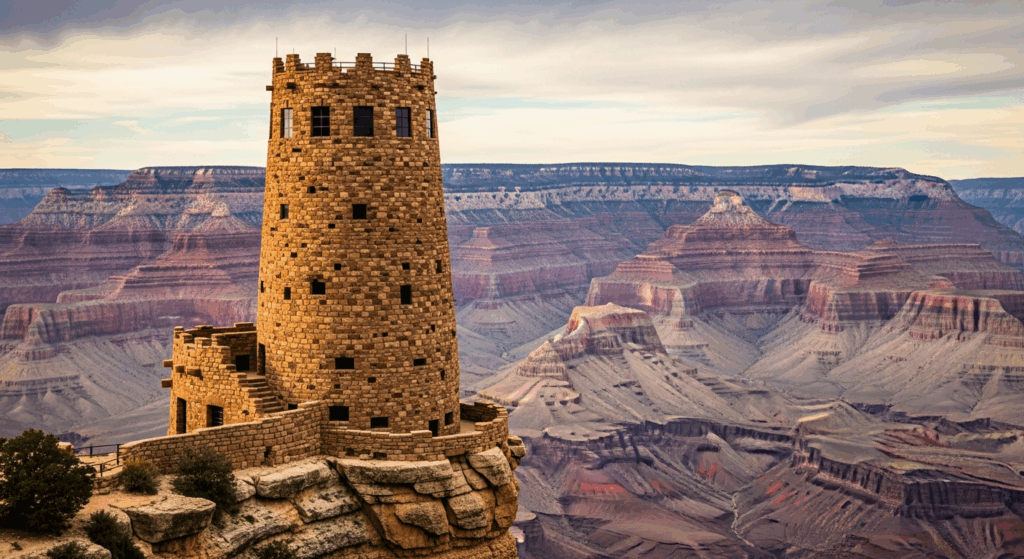The Grand Canyon’s South Rim offers some of the most accessible and iconic vistas in the world. Open all year, it provides the classic views you often see in photographs. Indeed, the South Rim attracts the vast majority of the park’s visitors for good reason. . This guide will walk you through the can’t-miss viewpoints and photo spots, helping you capture the canyon’s immense beauty. Source

The Gateway Views: Mather and Yavapai Points
Most visitors get their first jaw-dropping look at the Grand Canyon from Mather Point. Located just a short walk from the main visitor center, it offers a sweeping 180-degree panorama. The view here is vast and almost overwhelming. For photographers, Mather Point is a phenomenal spot for sunrise. The rising sun paints the canyon walls in soft, warm colors, creating a truly magical scene. However, be prepared for crowds, as its accessibility makes it extremely popular.
Just a short walk west along the Rim Trail, you will find Yavapai Point. This viewpoint provides a slightly different, more westward-facing perspective. Furthermore, it is home to the Yavapai Geology Museum. Inside, large windows perfectly frame the canyon, allowing you to learn about the rock layers you are seeing. This combination of stunning views and educational exhibits makes Yavapai Point an essential stop. You can clearly see the Colorado River and Phantom Ranch from this location, offering a glimpse into the canyon’s depths.
West Rim Wonders: The Hermit Road Scenic Drive
The Hermit Road is a seven-mile route that follows the canyon rim westward from Grand Canyon Village. For most of the year (March 1 to November 30), you must use the free park shuttle to access this road. This system helps reduce congestion and preserve the area’s tranquility. Consequently, the viewpoints along Hermit Road often feel more serene than those in the main village area.
Hopi Point: The Sunset Superstar
If you can only choose one spot for sunset, many photographers would recommend Hopi Point. It juts out farther into the canyon than any other viewpoint on the South Rim. This unique geography provides unobstructed, panoramic views to both the east and west. As the sun goes down, it casts dramatic shadows that reveal the canyon’s intricate textures. Therefore, arriving early is crucial to secure a good spot, as it is a very popular sunset destination.
Mohave and Pima Points
Continuing west, Mohave Point offers spectacular views of several major rapids on the Colorado River, including Hermit and Granite Rapids. The perspective here is more direct and looks down into the inner gorge. It is an excellent location for photographers using a telephoto lens to capture the river’s power. Additionally, Mohave Point provides a great look at the challenging Hermit Trail as it descends into the canyon.
Finally, at the end of the shuttle route lies Pima Point. One of the unique features of this viewpoint is the sound. On quiet days, you can often hear the roar of the Colorado River echoing up the canyon walls. This auditory experience adds another dimension to the visual splendor. Pima Point is generally less crowded than Hopi Point, making it a peaceful alternative for watching the sunset.
. Desert View Drive – Grand Canyon National Park
East Rim Exploration: The Desert View Drive
Unlike Hermit Road, the 23-mile Desert View Drive is open to private vehicles all year. This scenic route travels east from Grand Canyon Village toward the park’s East Entrance. It features several amazing pullouts, each offering a distinct personality and view.
Grandview and Moran Points
Grandview Point was one of the first tourist destinations at the canyon. It lives up to its name with expansive views of Horseshoe Mesa and various buttes. The area feels more rugged and less developed than the village viewpoints. For instance, the stone walls are lower, providing a more natural viewing experience. It is also the starting point for the steep and strenuous Grandview Trail.
Moran Point is another must-see stop, named after the famous landscape painter Thomas Moran. This spot is known for showcasing the different rock layers of the canyon. Specifically, a distinct block of Redwall Limestone is a prominent feature. The view here is a geologist’s dream and a painter’s inspiration, offering a rich tapestry of colors and formations, especially in the late afternoon light.
. Lipan Point – Grand Canyon National Park
Lipan Point and Desert View Watchtower
For one of the widest, most encompassing views of the Grand Canyon, head to Lipan Point. From here, you can see the Grand Canyon Supergroup, a set of ancient, tilted rock layers. It also provides one of the best views of the Colorado River on its journey through the canyon. Subsequently, it has become a favorite for photographers seeking to capture the full scale of this natural wonder.

Your final stop on the drive should be the Desert View Watchtower. This 70-foot-tall stone tower was designed by architect Mary Colter in 1932. You can climb to the top for a 360-degree view that is truly breathtaking. Looking east, you can see the Painted Desert, while the west reveals the canyon stretching out before you. The tower itself, with its intricate interior murals, is a work of art, making this a perfect capstone to your South Rim tour.

